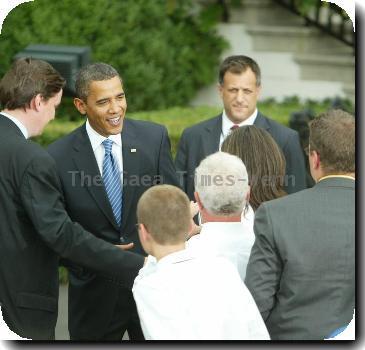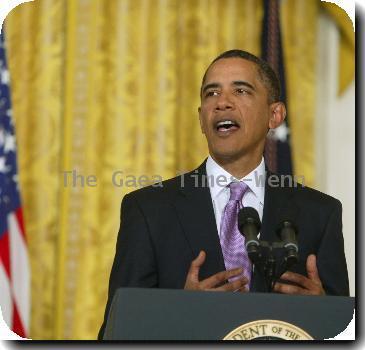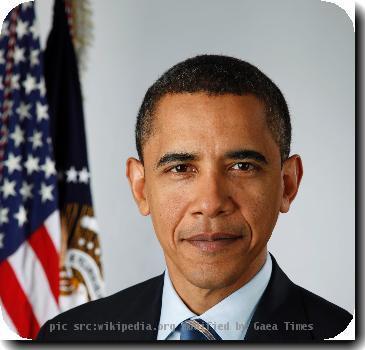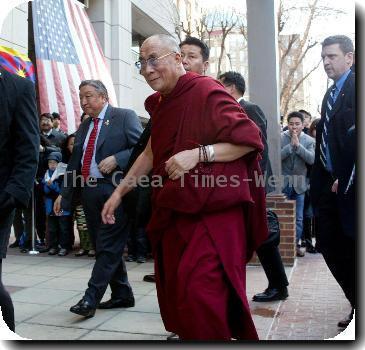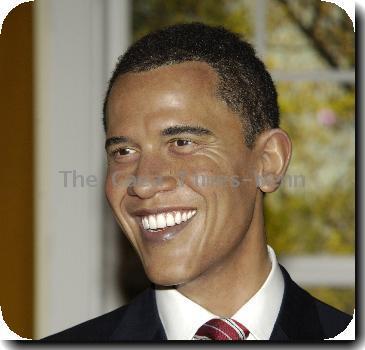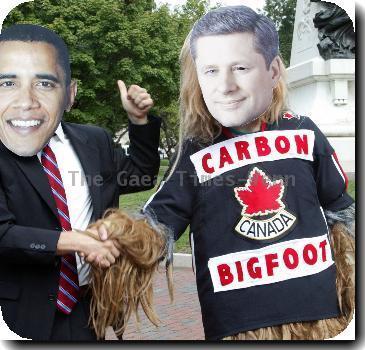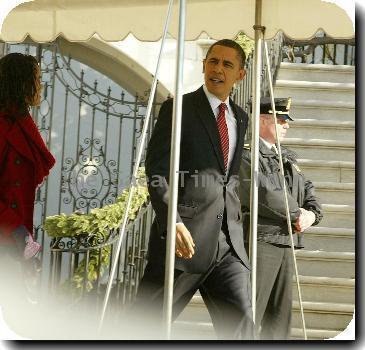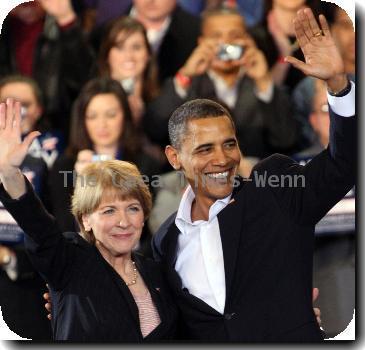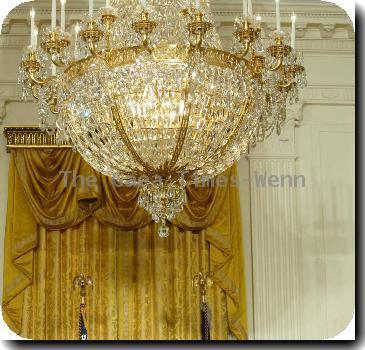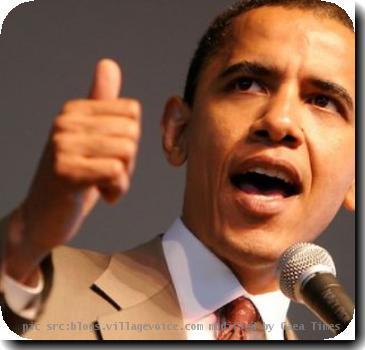Officials say Polish president, dignitaries among 97 victims of Russian plane crash
By Jim Heintz, APSaturday, April 10, 2010
Polish leader, 96 others dead in Russia jet crash
SMOLENSK, Russia — The crash of an aging Russian airliner ravaged the top levels of Poland’s military, political and church elite Saturday, killing the Polish president and dozens of other dignitaries as they traveled to a ceremony commemorating a slaughter that has divided the two nations for seven decades.
Poles wept before their televisions, lowered flags to half-staff and taped black ribbons in their windows after hearing that President Lech Kaczynski and the upper echelons of the establishment lay dead in woods a short drive from the site of the Katyn forest massacre, where 22,000 Polish officers were killed by Soviet secret police in one of Poland’s greatest national traumas.
Thousands of people, many in tears, placed candles and flowers at the presidential palace in central Warsaw. Many called the crash Poland’s worst disaster since World War II.
Twenty monks rang the Zygmunt bell at Krakow’s Wawel Cathedral — the burial spot of Polish kings — a tolling reserved for times of profound importance or grief.
The crash also shocked Russia. Sensing the depth of the tragedy for Poland, Prime Minister Vladimir Putin personally took charge of the investigation and very quickly and publicly offered condolences, along with Russian President Dmitry Medvedev.
“On this difficult day the people of Russia stand with the Polish people,” Medvedev said, according to the Kremlin press service.
Chunks of the plane were scattered widely amid leafless trees and small fires in woods shrouded with fog. A tail fin with the red and white national colors of Poland stuck up from the smoking debris. Early indications pointed to pilot error in heavy fog as a factor in the crash, officials said.
On board were the national bank president, deputy foreign minister, army chaplain, head of the National Security Office, deputy parliament speaker, Olympic Committee head, civil rights commissioner and at least two presidential aides and three lawmakers, the Polish foreign ministry said. Kaczynski’s wife, Maria, also died.
“This is unbelievable — this tragic, cursed Katyn,” Kaczynski’s predecessor, Aleksander Kwasniewski, said on TVN24 television.
It is “a cursed place, horrible symbolism,” he said. “It’s hard to believe. You get chills down your spine.”
Polish Prime Minister Donald Tusk and some cabinet members flew to Smolensk from Warsaw. The president’s twin brother, former Prime Minister Jaroslaw Kaczynski, headed to the area in a chartered plane along with party members.
Television showed Jaroslaw kneeling and praying at the crash site. Tusk, joined by Putin, placed a wreath at the site and knelt. When he stood up, Putin hugged him.
Afterward, Putin and Tusk held a video conference with members of a special commission in Moscow, who told them that doctors, psychologists and other specialists were ready to assist relatives of the victims. They said some bodies have already been flown to Moscow for identification and were being taken to the morgue.
The Polish military suffered the deepest losses. Among the dead were the army chief of staff, the navy chief commander, and heads of the air and land forces, who were all making the emotional trip to honor the Polish officers slain by the NKVD, the acronym for the Soviet secret police at the time of the killings in 1940.
Some on board were relatives of the officers slain in the Katyn massacre. Also among the victims was Anna Walentynowicz, whose firing in August 1980 from the Lenin Shipyards in Gdansk sparked a workers’ strike that spurred the eventual creation of the Solidarity freedom movement.
“This is a great tragedy, a great shock to us all,” former president and Solidarity leader Lech Walesa said.
Polish Parliament Speaker Bronislaw Komorowski, who became acting president, addressed his country on television: “Poland is in mourning, we have suffered a dramatically painful loss.”
He said he would announce early elections within 14 days of the president’s death, in line with the constitution. The vote must be held within another 60 days.
Russia’s Emergency Ministry said there were 97 dead, 88 in the Polish state delegation. Poland’s Foreign Ministry said there were 89 people on the passenger list but one had not shown up for the roughly 1 1/2-hour flight from Warsaw’s main airport.
Poland called for two minutes of silence across the country Sunday and declared a week of mourning. Medevedev declared Monday a day of mourning in Russia.
In the village of Gorzno, in northern Poland, the streets were largely empty as people stayed home to watch television.
“It is very symbolic that they were flying to pay homage to so many murdered Poles,” said resident Waleria Gess, 73.
The deaths were not expected to directly affect the functioning of Polish government: Poland’s president is commander in chief of its armed forces but the position’s domestic duties are chiefly symbolic. No top government ministers were aboard the plane.
Polish-Russian relations had been improving recently after being poisoned for decades over the massacre of some 22,000 Polish officers in and around Katyn forest.
Russia never has formally apologized for the deaths but Putin’s decision to attend a memorial ceremony earlier this week in the forest was seen as a gesture of goodwill toward reconciliation. Kaczynski wasn’t invited to that event because Putin, as prime minister, had invited his Polish counterpart, Tusk.
Rossiya-24 showed hundreds of people around the Katyn monument, many holding Polish flags, some weeping.
Kaczynski, 60, was the first serving Polish leader to die since exiled World War II-era leader Gen. Wladyslaw Sikorski in a mysterious plane crash off Gibraltar in 1943.
The president was a conservative and a lifelong skeptic of Russia with many detractors at home and abroad. Condolences from world leaders paid tribute to his patriotism and defense of freedom during Communist rule in Poland.
Putin and Medvedev promised Tusk they would work closely with Poland in investigating the crash. Initial signs pointed to an accident, possibly due to the fog that is very common in the area in spring and fall, as well as pilot error.
Both black boxes have been found. Preliminary data indicated that the plane hit the treetops as it was making the approach to the airport in poor visibility, the ITAR-Tass news agency quoted Marina Gridneva, an official with the Russian general prosecutor’s office, as saying.
Andrei Yevseyenkov, spokesman for the Smolensk regional government, said Russian dispatchers had asked the Polish crew to divert from the military airport in North Smolensk and land instead in Minsk, the capital of neighboring Belarus, or in Moscow to the east because of the fog.
While traffic controllers generally have the final word in whether it is safe for a plane to land, they can and do leave it to the pilots’ discretion. Air Force Gen. Alexander Alyoshin confirmed that the pilot disregarded instructions to fly to another airfield. The Smolensk airfield is not equipped with an instrument landing system to guide planes to the ground.
“But they continued landing, and it ended, unfortunately, with a tragedy,” Alyoshin said. He added that the pilot makes the final decision about whether to land.
The Tu-154 was the workhorse of East Bloc civil aviation in the 1970s and 1980s. Poland has long discussed replacing the planes that carry the country’s leaders but said they lacked the funds.
According to the Aviation Safety Network, there have been 66 crashes involving Tu-154s in the past four decades, including six in the past five years. The Russian carrier Aeroflot recently withdrew its Tu-154 fleet from service, largely because the planes do not meet international noise restrictions and use too much fuel.
The presidential plane was fully overhauled in December, the general director of the Aviakor aviation maintenance plant in Samara, Russia told Rossiya-24. The plant repaired the plane’s three engines, retrofitted electronic and navigation equipment and updated the interior, Alexei Gusev said. He said there could be no doubts that the plane was flightworthy.
Kacyznski became president in December 2005 after defeating Tusk in that year’s presidential vote.
The nationalist conservative had said he would seek a second term in presidential elections this fall. He was expected to face an uphill struggle against Komorowski, the candidate of Tusk’s governing Civic Platform party.
Poland has become a firm U.S. ally in the region since the fall of communism — a stance that crosses party lines.
The European Union member nation of 38 million people sent troops to the U.S.-led war in Iraq and recently boosted its contingent in Afghanistan to some 2,600 soldiers.
U.S. Patriot missiles are expected to be deployed in Poland this year. That was a Polish condition for a 2008 deal — backed by both Kaczynski and Tusk — to host long-range missile defense interceptors.
The deal, which was struck by the Bush administration, angered Russia and was later reconfigured under President Barack Obama’s administration.
Under the Obama plan, Poland would host a different type of missile defense interceptors as part of a more mobile system and at a later date, probably not until 2018.
_____
Scislowska reported from Warsaw. Associated Press writers Deborah Seward in Paris, Vanessa Gera in Warsaw, Katarzyna Mala in Gorzno, Poland, and Geir Moulson in Berlin contributed to this report.
Tags: Accidents, Barack Obama, Condolences, Eastern Europe, Europe, Katyn massacre, Lech Kaczynski, Massacres, Moscow, North America, Plane crash, Poland, Polish president, Russia, Smolensk, Transportation, United States, Violent Crime, Vladimir Putin
